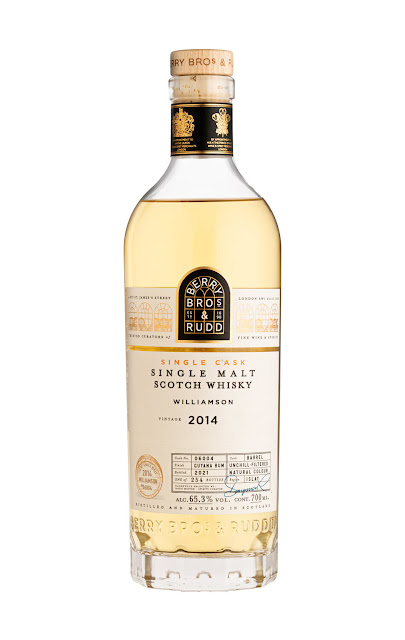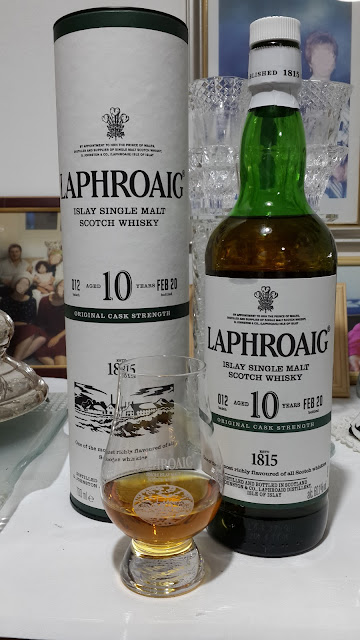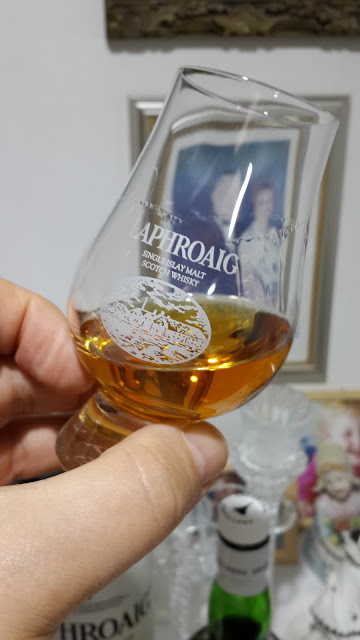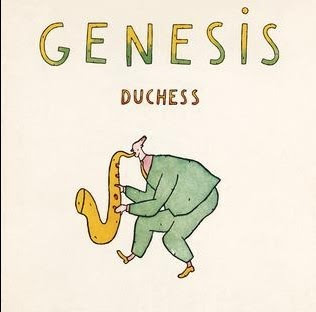Laphroaig 10-Year-Old Cask Strength (Official Bottling) Batch #012
Laphroaig 10-Year-Old Cask Strength (Official Bottling) Batch #012
I ended my last review, which covered the Laphroaig 10 (Standard Edition 40% abv) vs Laphroaig Quarter Cask, with the question: Is there a (near) perfect example out there (after the demise of the 18-Year-Old) where you can get that unique Islay Laphroaig flavour experience from an official bottling without compromise, or is this only possible from independent bottlers?
Independent Bottlings of Laphroaig
Let's look at the independent bottlings of Laphroaig available on the market today.
The first thing of note is, although not very common, there are a few to choose from, but it’s not always immediately clear you are actually buying spirit from Laphroaig. Many independent bottling companies have to resort to using strange and often very creative pseudonyms, as Laphroaig’s Japanese owner’s Beam Suntory, demand huge bucks for the use of their distillery name on the label.
Instead, independent bottles will use names which whilst not breaking any legal contracts, will try and let us know that this is in fact Single Malt from Laphroaig.
Imaginative names like "La Frog" have been used.
 |
| "La-Frog" |
 |
| "La Frog" |
Another Independent bottler – Berry Bros & Dudd (which as I have already related in my previous article, who were actually the first to bottle Laphroaig back in the 1920s), today use the Name “Williamson” on their bottles of Laphroaig. Why? Because this was the surname of the distillery’s most famous manager and owner, Bessie Williamson, one of the few women distillery managers of the 1960s. Not surprisingly, other independent bottlings have used the name “Bessie" as well.
 |
| "Bessie" |
 |
| "Williamson" |
 |
| "Williamson" |
Others simply say “Islay” or variations of. Almost all independent bottlings of Islay Single Malt have either come from Caol Ila distillery or Laphroaig, those being the largest producers of whisky on the island. The others don’t usually have excess stock available to sell. So, unless the whisky has been finished in some First-Fill active Sherry cask, you can usually tell from which of the two Islay distilleries the spirit has come from, because the signature flavour profiles of Caol Ila and Laphroaig, whilst both being Islay Peated Single Malts, are significantly different - Caol Ila being more lemony and grilled meat flavours and Laphroaig being much more pungent and "sea-weedy".
Marks & Spencer’s Food department sells their independent bottlings of a mystery Islay distillery but it’s not difficult to guess which one.
The M&S Islay 10-Year-Old comes in a suspiciously familiar green bottle (ahem) and the labelling artwork closely mimics (but presumably don’t quite come legally close enough) to the official bottlings of Laphroaig.
 |
| Can you guess where "Islay 10" is from? |
Based upon all the independent bottlings of Laphroaig that I have tried over the years, my opinion is that it’s a somewhat hit or miss affair. A lot are in my opinion, simply too young to have been bottled and those that aren’t, are frankly, just not worth paying the high prices asked for.
The question is, does the 10-Year-Old Cask Strength official releases which are now readily available (at least in the UK) and come with a reasonable price, represent a better option for the Integrity bottling Laphroaig enthusiast?
My recent experience with an independent bottling of Laphroaig is a case in point. I was at the Jerusalem Whisky Festival 2023 back in May and sampled a really nice Laphroaig (yes, it was actually called “Laphroaig”") by Independent Bottlers “Duncan Taylor”.
It checked all the boxes: 10 Years Old (Check), Cask Strength 53.4% (Check, but having said that, for a Cask Strength whisky, it was a suspiciously low abv for a 10-YO). Distilled 09.2011, Bottled 03.2022, No of bottles: 172 (which is also strangely low for a standard single 200L Ex-Bourbon Barrel where you would typically get around 250 bottles from the barrel). That low abv and small number of bottles might indicate a possible leakage problem with the cask? (Just saying!)
What was not stated however was whether it was Non-Chill Filtered or Natural Colour!!! By the looks of it, it was obviously natural colour and the rich mouth feel indicated that this Duncan Taylor had only been barrier filtered. Nonetheless, the main reason for buying Indie bottles is for the Integrity credentials and not stating these two things on the label is a real own goal. It’s simply bad marketing.
The labelling mess continues as it states a Cask Number No. 56400 but no mention of what type that cask is! Inquiries to the company assured me that yes, the release was NCF and NC and the cask was an Ex-Bourbon barrel, as suspected.
What a shame that we have a very lazy generic label statement written in bold, "Matured in Oak Casks". Yes, “Casks” in plural, even though this is a Single Cask batch!!!
No doubt they use this same standard label for all their batches. They think they are saving on production costs. It’s a false economy in my opinion. Whisky enthusiasts who are prepared to spend this amount of money shouldn’t put up with this lack of transparency. As I said, they aren’t intentionally withholding information, they just can’t be bothered to customise their releases to give us the information we deserve to know.
It reminds me of the time I was browsing in a specialist whisky shop in Speyside and came across a special edition, a Single Cask release from a distillery which has Kosher certification for all their core ranges. The problem was that this Single Cask was a First-Fill (Stam Yeinum) Ex-Sherry Butt and the distillery had neglected to remove the hechsher from the standard label! A phone call to the Kashrus organisation followed up with photos via email, did not result initially in any action. Only when I contacted the distillery manager did he take the issue seriously. Then all of a sudden, the Kashrus organisation reacted. Ma-la'asot!
In summary, the label was an absolute train wreck and someone at Duncan Taylor ought to be thoroughly ashamed of themselves for this utter shambles.
Samples could be had for two of my festival tokens (yes, they insisted on two tokens out of the five which were given to me upon entry to the festival). However, they did give me quite a generous dram.
Tasting Notes of the Duncan Taylor 10-Year-Old
Tasting the sample back at home, this Indie Laphroaig, which was in my estimation, matured in a Second-Fill Ex-Bourbon Barrel, was really lovely. This Duncan Taylor Single Cask demonstrated absolute classic Laphroaig flavours but was cleaner and much more focused than the standard official bottling 10-Year-Old.
You are first presented with a big syrupy mouth feel of sweet seaweed peat, black pepper, wild honey and followed up with some Vanilla Yeast cake.
There were some nice spicy notes at the end as well. There are some independent bottlings which don't share the house style character of the official bottlings, but I'm happy to say that this one did.
Conclusion
Although very nice and giving a genuine Laphroaig experience, the main concern for me was the price. Whilst independent bottlings of Caol Ila seem to be readily available and relatively good value for money, spirit originating from Laphroaig is often sold far too young or comes with a premium price tag.
At the eye watering price of about 650 shekels (That's about £135) for this independent 10-Year-Old bottling, as tasty as it is, I can’t in all conscious recommend it when you consider that Official Bottlings of Laphroaig Cask Strength 10-Year-Old are around £75 in the UK. Other Non-Age Statement and 4–6-Year-Old Laphroaigs available from independent bottlings are obviously cheaper but they are too immature and will in my opinion, leave you disappointed.
This is the current situation in Israel at least, but if you live in say Sweden or Germany where the independent bottling market is much more established and where you are able to get 10-year-old or older Laphroaigs at much more reasonable prices, then this is definitely the preferred choice over all the distillery’s official bottlings. Well, perhaps all except one. That’s the 10-Year-Old Cask Strength.
So, just how good are these annual releases and how many of the Integrity list check-boxes do they tick?
The 10-Year-Old Cask Strength Phenomena
 |
| Cask Strength (Left) Standard (Right) |
First released as an experiment and known to collectors as “The Original Red Stripe”, it was an instant success amongst the growing number of Laphroaig fans. The first annual Vintage release - Batch 001 was released in February 2009. Originally only available for purchase at the distillery, which is where I bought my first bottle - The “Batch 003”. Picking up one of these bottles became one of the many growing "Must" reasons to visit Islay. Originally sold at the distillery shop for around £50, these early batches are still available today but are now retailing for around £300-400.
In the last few years however, the latest annual Limited-Edition batches are also to be found in specialist whisky shops and online Whisky stores in the UK such as The Whisky Exchange and Master of Malt, which is where I purchased this Batch 12 that I am about to review.
Laphroaig Cask Strength 10-Year-Old, Official Annual Bottling.
Batch: 012
Bottled At: 60.1% abv
Filtration: Non-Chill Filtered. The back label states “Barrier Filtered Only”*
Colour: Natural Colour. (This only applies to Batch 12)*
Released: February 2020 (At the beginning of Covid)
Maturation: Heavily Charred Ex-Bourbon Barrels*
Kashrus Status: No Certification but seems to have no Kashrus issues.
*Information received from John Campbell, the then Manager.
Some background
The Cask Strength 10-Year-Old Batch #012 was released just as COVID began to hit hard, back in February 2020. So, there we were already in July, in what was our second national lockdown in Israel. Trapped in our apartment, not knowing when we would be allowed to leave our homes to go to the supermarket, let alone when the airports would once again be open for business and we would be allowed to travel to the UK.
Thinking that it could be a year or more before I could get to see the white cliffs of Dover (fog permitting), I decided to treat myself to a special online order from The Whisky Exchange in London and indulge myself with two “feel good” special Single Malts.
It would be the first and so far, last time I would order online from the UK for the bottles to be delivered to my home address in Israel. As I was soon to find out, despite not having to pay the 20% VAT for inside UK purchases, I was slapped with a Customs and excise TAX here in Israel of about NIS 300 that more than ate up the initial saving.
Despite that Customs bill, I sure was excited to receive the package. The UK no longer felt so far away anymore.
I have already written a review of the delicious Old Ballantruan 15.
You can read it here:
Delivery Packaging
I must admit to being really impressed how The Whisky Exchange packed these two bottles. Each one was safe and sound in its own Bubble Wrap bag.
Compare this to my recent TWE order when I had two bottles delivered to my parents’ home in England. They were wrapped in rolls and rolls of some recycled brown paper, no doubt in an attempt to save the planet! I can just imagine how much longer it must have taken the poor TWE worker to wrap these bottles, compared to just slipping the whiskies into these custom plastic bubble wrap bags. That’s the cost of UK’s obsession with Net Zero for you.
Batch 012 is a true Integrity Bottling – but that doesn’t mean that all the batches are!
As travel to the UK was still out of the question, we decided to spend a week just before Rosh Hashana on holiday in the Golan Heights in August 2020.
Even with all the restrictions, we were still able to visit the Golani Distillery, a few wineries as well as some outdoor museums. I even got to visit the famous Shofar factory and buy a new Shofar for the Chag (festival).
Whilst there, I received an email from Laphroaig inviting me to join a Live YouTube “Special Covid Lockdown” stream, with the then distillery manager, John Campbell (now at Lochlea Distillery). There was a live Chat where they answered your questions. When I asked about Chill filtration and Colouring, John proudly replied that the Cask Strength Batch 12 was Non-Chill-Filtered and Natural Colour! However, when I asked him why they don't state Natural colour on the label, he didn't respond.
The back label does indeed state that the whisky has been “Barrier Filtered Only”, which means that it hasn’t been chill-filtered. I wish that they could have just simply stated “Non-Chill Filtered” on the front label though.
Drowning In Water
The back label bizarrely states, “We recommend that you add twice as much water as whisky to fully appreciate the taste characteristics of Original cask Strength Laphroaig”.
What are they talking about? This surely must be a mistake. So, they are recommending that we drink this whisky 1/3 spirit and 2/3 water! Listen, I am a big proponent of adding water but this is simply ridiculous. I understand that subsequent batches do not contain this “recommendation”.
Packaging
Please see the previous review about Laphroaig 10 Year Old vs The Quarter Cask where I discuss the general Laphroaig packaging and artwork.
Heavily Charred Ex-Bourbon Barrels
Another revelation which we learnt from that Live Stream is that, unlike previous editions, Batch 012 was matured in specially prepared heavily charred Ex-Bourbon barrels. This will no doubt have a significant effect on the flavour of this batch.
Neck Pour Tasting Notes
(These were my initial rough draft, non-analytical tasting notes upon opening the Batch 012. It’s what they call “The Neck Pour” review).
Initial Impressions
Appearance
Golden Brown.
The tears on this are thick and syrupy. They just stick to the glass like Rubber glue. This confirms the high alcohol level and that it's Non-Chill Filtered. (Good Start).
On The Nose
Even without water, the first thing you notice is that it has an intensely sweet coastal fresh tar aroma like a newly built road leading down to the beach. Then, that sweetness comes into focus. It’s black toffee with a hint of black liquorish. The peat smoke is dense like burnt salty twigs, seaweed and seagrass.
The whole experience is so all consuming, yet in seeming contradiction, you can get your nose right into the glass and breathe deeply without any hint of harshness or nose burn, despite the incredibly high 60.1 % alcohol by volume. It’s so all-consuming but doesn’t seem to overwhelm the senses.
Yes, I haven’t even added any water yet. My nose became acclimatised to the big tar notes and I started to notice syrupy sultanas, yellow apples, yellow tropical fruits like pineapple and mango. What I wasn’t expecting however were aromas of fried eggs, toast and onions in a frying pan served in a “Joe’s Caff” on the beach.
Tasting
 |
I thought it was time to take a sip, just to see what it was like without water. The whisky simply explodes wildly in the mouth, overwhelming all your senses with a multitude of powerful flavours, all vying for your attention.
What would water do to this monster? My recommendation is to add a half a teaspoon at a time, every half a minute for two minutes. (Two teaspoons in all).
With water, things come more into focus but does not lose intensity. Instead, flavours are multiplied. I could now identify rich smoky fat sausages with HP Sauce.
HP (“Houses of Parliament”) Sauce - A classic British condiment developed by a grocer named Frederick Gibson Garton in 1884, who combined tomatoes, glucose-fructose syrup, cornflour, malt flour, dates, molasses, malt vinegar and soy sauce, along with a hint of Indian spice influence which includes Tamarind - found in cafes and restaurants (including kosher ones) all over Britain.
The Finish
Sweet seaweed, salty stones, brown sugar and a touch of Marmite. Charred black caramelised wood, smoky honey breakfast cereal, soft wood spices and more coastal tar on the long-long-long finish.
Two Weeks Later
If anything, the flavours were even more pronounced.
On the Nose
Initially an intense smell of sweet tar. Syrupy sultanas. Yellow apples. Fried Sausage, Eggs and onions. Smoky burnt sweet and salty wood char.
Mouth Feel
Unlike the Laphroaig 10-Year-Old standard edition which was very disappointing, this Cask Strength Batch 012 is full bodied and oily. The brown liquid engulfs the entire mouth; the cheeks, gums, tongue and teeth with sweet fruity syrupy burnt toffee flavours.
Tasting
Smoked Vienas (Red boiling sausages) smoked “Vursht” - Blooms Salami.
Sweet Seaweed. Salty stones. Brown sugar. Charred black caramelised wood.
Smoky honey breakfast cereal. Fried eggs and onions.
Finish
The fatty toffee and seaweed flavours gradually dissipate after 15 minutes or so.
Conclusion
My favourite Rock Genesis album is “Duke”, released in 1980. Its sheer emotional musical power and complexity is guaranteed to bring a lump to the throat and get me humming along to all the tracks (except “Misunderstanding” which I usually skip).
It's the same with Laphroaig Cask Strength.
In my opinion, when you are in the mood for a Laphroaig (and the truth is, at least for me, it’s not a whisky experience I could take every day), then this cask Strength is the one to pick up. It has everything we love about Laphroaig in bucket loads. From the first sniff, the aromas, the mouth feel, the drinking experience right up to its long-long finish, It is near Islay whisky perfection. But such an intense and all-encompassing drinking experience should be reserved for that special occasion when one has time to relax and appreciate the whisky experience this King of Islay Malts can give you.
Other Batches
Those heavy sweet burnt toffee notes from the charred barrels of Batch #012, make this, in my opinion, by far the sweetest of all Cask Strength Laphroaig editions. As I understand it, it was a bit of an experiment at the time. What’s more, the dark toffee brown colour of the whisky was all natural, derived solely from those charred casks. Adding E150a to the whisky would have been a complete waste of time.
The Cask Strength 10 Batch #013, 57.9 % abv was available in early 2021. 100% Ex-Bourbon Barrels but had less of a burnt Oak flavour to it.
The Cask Strength 10 Batch #014, 58.6 % abv, came out later in the same year, available in late 2021. Again, 100% Ex-Bourbon barrels but a slightly dryer version with more peat, seaweed notes.
The Cask Strength 10 Batch #015, 56.5 % abv, came out mid-2022. Matured exclusively, as always, in Ex-Bourbon Barrels, the casks had been given medium char, similar to the 12, and made for a sweeter edition.
The Cask Strength 10 Batch #016, 58.5% abv, came out in December 2022.
Some of these later batches, although all state that they are Non-Chill Filtered, may well contain some E150a colourant in them. As the official spokesperson said to me in an email - "We reserve the right to add Caramel Colouring". Such is the problem where corporate executives and not distillery managers make the decisions.



















Comments
Post a Comment
--------------------------------------------------------------------------------
Please enter your comment above this line, and then click on the PUBLISH button (on the far right hand side).